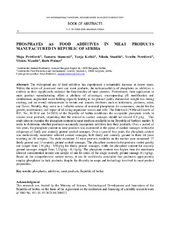Приказ основних података о документу
Phosphates as food additives in meat products manufactured in republic of Serbia
| dc.creator | Petričević, Maja | |
| dc.creator | Stamenić, Tamara | |
| dc.creator | Keškić, Tanja | |
| dc.creator | Stanišić, Nikola | |
| dc.creator | Petričević, Veselin | |
| dc.creator | Mandić, Violeta | |
| dc.creator | Pisinov, Boris | |
| dc.date.accessioned | 2023-10-10T08:31:44Z | |
| dc.date.available | 2023-10-10T08:31:44Z | |
| dc.date.issued | 2023-10 | |
| dc.identifier.isbn | 978-86-82431-81-7 | |
| dc.identifier.uri | http://r.istocar.bg.ac.rs/handle/123456789/892 | |
| dc.description.abstract | The widespread use of food additives has experienced a remarkable increase in recent years. Within the realm of processed meat and meat products, the indispensability of phosphates as additives is evident, as they significantly enhance the functionality of meat proteins. Furthermore, their application in meat product manufacturing offers a plethora of advantages, encompassing pH modification and stabilization, augmented water holding capacity leading to heightened yields, diminished weight loss during cooking, and an overall enhancement in texture and sensory attributes such as tenderness, juiciness, color, and flavor. Notably, they serve as a valuable source of essential phosphorus for consumers, crucial for the growth, maintenance, and repair of all living organisms' tissues and cells. The Rulebook ("Official Gazette of RS", No. 50/2019 and 34/2023) of the Republic of Serbia establishes the acceptable phosphate levels in various meat products, stipulating that the amount in cooked sausages should not exceed 8.0 g/kg. This study aims to examine the phosphate content in meat products available in the Republic of Serbia's market. It seeks to determine whether producers accurately incorporate additives into their products. Over a period of two years, the phosphate content in meat products was monitored in the group of cooked sausages within the subgroups of finely and coarsely ground cooked sausages. Over a span of two years, the phosphate content was meticulously monitored selected cooked sausages, both finely and coarsely ground in three lot years resulting in 156 samples. The study examined 52 meat products available on the market were examined: 37 finely ground and 15 coarsely ground cooked sausages. The phosphate content in the products varied greatly and ranged from 2.01g/kg - 6.98g/kg for finely ground sausages, while the phosphate content for coarsely ground sausages ranged from 3.33g/kg - 9.15g/kg. The phosphate content was higher than the maximum allowed concentration in only one sample of one lot series of the single coarsely ground sausage (9.15g/kg). Based on the comprehensive market survey, it can be confidently concluded that producers appropriately employ phosphates in their products, despite the diversity in scope and technology involved in meat product preparation. | sr |
| dc.language.iso | en | sr |
| dc.publisher | Institute for Animal Husbandry, Belgrade-Zemun | sr |
| dc.relation | info:eu-repo/grantAgreement/MESTD/inst-2020/200022/RS// | sr |
| dc.rights | openAccess | sr |
| dc.rights.uri | https://creativecommons.org/licenses/by/4.0/ | |
| dc.source | Book of abstracts of the 14th International Symposium „Modern trends in livestock production“ | sr |
| dc.subject | phosphates | sr |
| dc.subject | additives | sr |
| dc.subject | meat products | sr |
| dc.subject | Republic of Serbia | sr |
| dc.title | Phosphates as food additives in meat products manufactured in republic of Serbia | sr |
| dc.type | conferenceObject | sr |
| dc.rights.license | BY | sr |
| dc.citation.spage | 72 | |
| dc.citation.epage | 72 | |
| dc.identifier.rcub | https://hdl.handle.net/21.15107/rcub_ristocar_892 | |
| dc.identifier.fulltext | http://r.istocar.bg.ac.rs/bitstream/id/4294/bitstream_4294.pdf | |
| dc.type.version | publishedVersion | sr |


